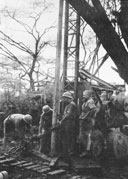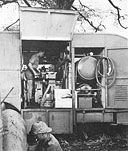
5
1st S.A. Division arrives
On 7 October the Dukes were relieved in the Turkana and returned to Habaswein to rejoin 1st S.A. Infantry Brigade Group,1 which was engaged in intensive training in night driving in the scorched wilderness where a daytime temperature of over 110 degrees Fahrenheit2 in the shade was commonplace--if one could find any shade. With 1st Transvaal Scottish also returning to Habaswein from the nomads' crossroads of Melka Galla, with its grass huts and abundant game, there was a feeling among the men that at last action was in the offing. After light rains--not yet enough to turn the silt back into a swamp--blades of grass and tiny flowers peeked out above the dry mud and sprouting leaves on the trees brought welcome shade.3
On 11 November 1940, the Headquarters of 1st S.A. Division--totalling 26 officers and 132 other ranks apart from Divisional Troops--landed at Mombasa and entrained for Gilgil, where they opened on 16 November. With them came 15th Field Ambulance, S.A.M.C. (Lieutenant-Colonel Eric McKenzie), which had originally been intended as a 2nd S.A. Division unit, but had engineered its attachment to 1st S.A. Division.
Sir Pierre van Ryneveld was now offering General Cunningham a further five brigades of field artillery still in South Africa, temporarily equipped with 3-inch mortars and becoming restless through lack of action. The Force Commander, with barely enough ammunition for available mortars, could not accept the offer but hoped that 18-pounder and 4·5-inch howitzer equipment for these batteries might shortly become available in the Middle East on replacement there by new 25-pounders. In the meanwhile he would gladly accept any 18-pounder battery if it came with its stores complete.
The 2nd S.A. Infantry Brigade Group came under command 1st S.A. Division the day the Divisional Headquarters opened, but 1st S.A. Infantry Brigade Group remained attached to 12th African Division, under whose wing it was conducting rehearsals for its first operation against the enemy. 'A' Company of 15th Field Ambulance was also attached temporarily to 12th African Division and moved from Gilgil to Mitubiri, where it treated many West African patients.
Bad weather and deficiencies in equipment led to postponement of the projected operation in which 1st S.A. Brigade Group was to be associated with other troops in the capture of some small post, as 12th



